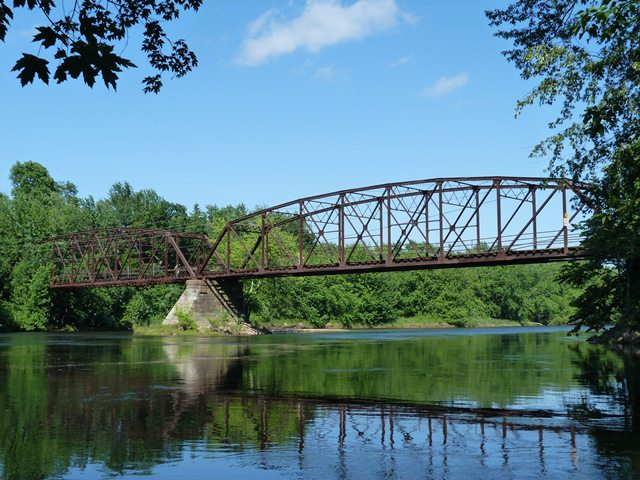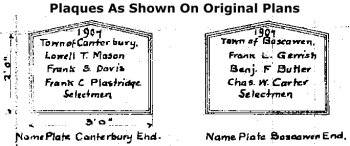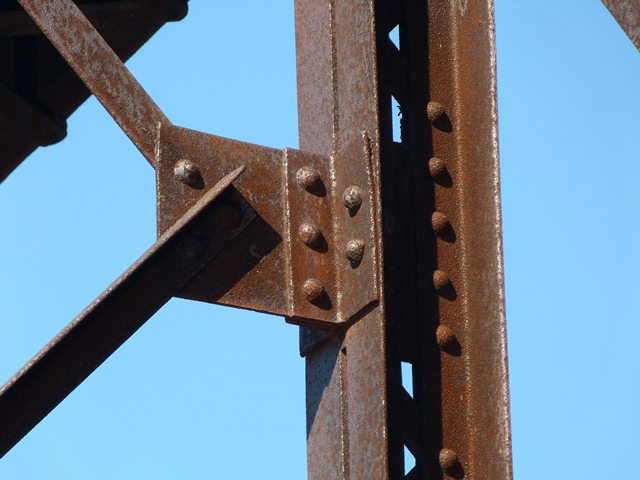We Recommend:
Bach Steel - Experts at historic truss bridge restoration.
BridgeHunter.com Phase 1 is released to the public! - Visit Now
Boscawen - Canterbury Bridge

Primary Photographer(s): Nathan Holth
Bridge Documented: June 16, 2012
Boscawen and Canterbury: Merrimack County, New Hampshire: United States
1907 By Builder/Contractor: American Bridge Company of New York, New York and Engineer/Design: John W. Storrs of Concord, New Hampshire
Not Available or Not Applicable
170.0 Feet (51.8 Meters)
347.0 Feet (105.8 Meters)
17.4 Feet (5.3 Meters)
2 Main Span(s)
2601320008500

View Information About HSR Ratings
Bridge Documentation
This bridge no longer exists!
Bridge Status: Demolished with no replacement bridge built.View Archived National Bridge Inventory Report - Has Additional Details and Evaluation
View The Memorandum of Agreement For The Demolition of This Historic Bridge
View A Detailed Documentation For This Historic Bridge, Including Original Plans
This bridge is an impressive two-span through truss. With a 1907 construction date, it is the oldest rivet-connected Parker through truss bridge in New Hampshire. The bridge retains good historic integrity. The bridge's pipe railing is not original, but was in place by 1940. The original railing was wooden planks. The bridge also has an extremely unusual flooring system, which is part of the original design. Typically, a series of closely spaced longitudinal deck stringers rest on the floorbeams, while a deck surface rests on the longitudinal stringers. On this bridge, there are instead three large longitudinal stringers, one at each side of the bridge, and one running down the center. Resting on these, are transverse deck stringers, which hold the wooden deck surface above. This design of deck is extremely unusual and should be considered a significant aspect of the bridge.
Despite the bridge's obvious historic significance, and despite that fact that the bridge is not in the way of anything (no replacement structure is planned for this location) the bridge is to be demolished. In other words, valuable taxpayer dollars will be expended for no other purpose than to reduce this beautiful historic bridge to a pile of scrap metal.
A detailed documentation of this bridge is available in a link above, and it discusses extensively the history and design of the bridge. However, it does contain some misleading statements about the condition of the bridge prior to the demolition project. It states that "A 2009 engineering study examined the condition of the trusses and the rehabilitation options and costs, concluding that removal was the only feasible option." This statement implies that the bridge was beyond repair, which is not correct. Additional news articles and discussion with the state Department of Transportation revealed that the official position was that the bridge was beyond repair. In particular, an engineer had stated that steel of this age could not be safely welded. However, this statement is completely false, and likely assisted in the pointless condemnation of this bridge to the scrap yard. Old steel, and even cast and wrought iron can be safely welded and indeed is frequently welded as part of routine restoration work. Anyone claiming otherwise lacks basic knowledge of metal truss bridge restoration technique. See the website www.historicbridgerestoration.com for details. Further discussion with the New Hampshire Department of Transportation revealed that finding money for restoration were also an issue, but if that was the case, the bridge could simply be left standing, or placed into storage until funds for restoration become available. HistoricBridges.org closely looked at the bridge in 2012, and found no deterioration that could not be addressed through typical restoration technique. Like many deteriorated truss bridges, deterioration was confined to isolated areas, such as the bottom chord and bottom chord connections. Also, the floorbeams were deteriorated, however floorbeams are often replaced during historic bridge rehabilitations.
|
Builder Plaque THEUNITED CONSTRUCTION CO. CONTRACTORS, ALBANY, N.Y. AMERICAN BRIDGE CO. OF N.Y. BUILDERS. BOSCAWEN, NH FRANK L. GERRISH, B. F. BUTLER, SELECTMEN C. W. CARTER. JOHN W. STORRS, CONSULTING ENGINEER. |
Canterbury Plaque 1907TOWN OF CANTERBURY LOWELL T. MASON FRANK S. DAVIS FRANK C. PLASTRIDGE SELECTMEN |
Boscawen Plaque 1907TOWN OF BOSCAWEN FRANK L. GERRISH BENJ. F. BUTLER CHAS. W. CARTER SELECTMEN |
![]()
Photo Galleries and Videos: Boscawen - Canterbury Bridge
Structure Overview
Original / Full Size PhotosA collection of overview photos that show the bridge as a whole and general areas of the bridge. This gallery offers photos in the highest available resolution and file size in a touch-friendly popup viewer.
Alternatively, Browse Without Using Viewer
![]()
Structure Details
Original / Full Size PhotosA collection of detail photos that document the parts, construction, and condition of the bridge. This gallery offers photos in the highest available resolution and file size in a touch-friendly popup viewer.
Alternatively, Browse Without Using Viewer
![]()
Structure Overview
Mobile Optimized PhotosA collection of overview photos that show the bridge as a whole and general areas of the bridge. This gallery features data-friendly, fast-loading photos in a touch-friendly popup viewer.
Alternatively, Browse Without Using Viewer
![]()
Structure Details
Mobile Optimized PhotosA collection of detail photos that document the parts, construction, and condition of the bridge. This gallery features data-friendly, fast-loading photos in a touch-friendly popup viewer.
Alternatively, Browse Without Using Viewer
![]()
Maps and Links: Boscawen - Canterbury Bridge
This historic bridge has been demolished. This map is shown for reference purposes only.
Coordinates (Latitude, Longitude):
Search For Additional Bridge Listings:
Bridgehunter.com: View listed bridges within 0.5 miles (0.8 kilometers) of this bridge.
Bridgehunter.com: View listed bridges within 10 miles (16 kilometers) of this bridge.
Additional Maps:
Google Streetview (If Available)
GeoHack (Additional Links and Coordinates)
Apple Maps (Via DuckDuckGo Search)
Apple Maps (Apple devices only)
Android: Open Location In Your Map or GPS App
Flickr Gallery (Find Nearby Photos)
Wikimedia Commons (Find Nearby Photos)
Directions Via Sygic For Android
Directions Via Sygic For iOS and Android Dolphin Browser
USGS National Map (United States Only)
Historical USGS Topo Maps (United States Only)
Historic Aerials (United States Only)
CalTopo Maps (United States Only)






